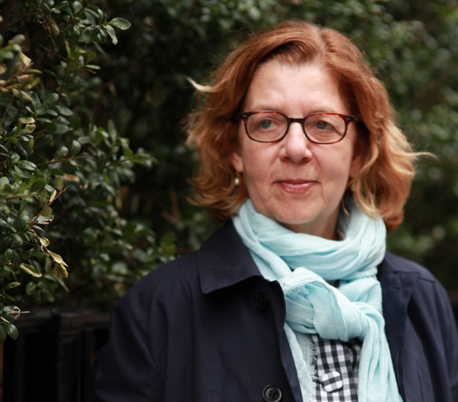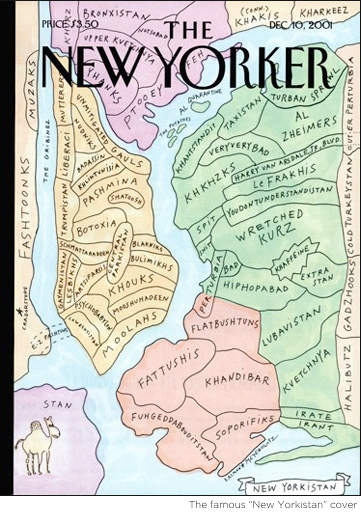
Location: New York, NY
Age: 61
Marital Status: Widowed
Education: B.A. in English from N.Y.U
When you ask FOF Maira Kahlman how she identifies herself, she suggests “illustrator,” then “writer” and, finally “designer.” “I don’t call myself an artist,” she says “because it implies something I’m not quite sure I am. I like to think of myself as an artist-at-large.”
Maira is best known for the irreverent drawings and musings in her twelve children’s books, including Fireboat (winner of the Boston Globe Horn award) and a well-known series of stories about a poet-dog named Max. But, it’s not all kid stuff—her graphic novels for aduts, The Principles of Uncertainty and And The Pursuit of Happiness have developed a cult following, and her 2001 New Yorker magazine cover, “New Yorkistan” depicting the boroughs and neighborhoods of New York City with fictional Middle Eastern sounding names, was named a top magazine cover from the last forty years by the American Society of Magazine Editors. In 2006 and 2007 the New York Times hired Maira as a “visual columnist” to churn out monthly illustrated blog posts.
“The last ten years have been extraordinary,” says Maira. “It’s been a combination of luck and hard work—and then more luck.”
I read somewhere you don’t like starting in the beginning. So let’s start somewhere else. Tell me about your life after 50…
I became a widow after fifty. There’s an old myth if you lose your mate, you’re lost. For me, the opposite was true, I found that I was even stronger than before. I was energized and motivated to work and to create.
How did you meet your husband?
In a summer class at N.Y.U. I was 18. We both flunked out of economics and had to retake it. That was the luckiest thing that ever happened to me.
What’s your proudest accomplishment after fifty?
Still working and being interested and curious about a million things and having people appreciate this.

You were an English major at N.Y.U. How did you get into illustration?
I was an English major like everyone else who didn’t know what they wanted to do. I wrote poetry and realized that it was awful, and I better stop doing it. But, I really needed to have a way to express myself. I liked children’s books and was inspired by people like Saul Steinberg. I thought that being a narrative opportunist and a narrative illustrator really made sense. I thought ‘oh, this is a world I can inhabit!’
Why did Saul Steinberg inspire you?
He was also an illustrator who travelled the world, wrote humorous narrative and had a love for typography and objects.
What else inspires you?
My children were a big inspiration for me. When I had children, that’s when I really started thinking about children’s books. In a bigger sense—traveling, music, fashion, literature, architecture and street life.
What books did you read with your own children?
We loved Dr. Seuss, Winnie The Pooh, and Alice in Wonderland. Pippi Longstocking was really important to me when I was a child.
How many children do you have?
Two, they are 28 and 25. They’re still children to me, but will soon have children of their own.
Are they artistic?
They’re both artistic. One is a chef and the other is a filmmaker. They both live in the city, and I think they’ve become addicted to New York. But they travel a lot.
And you’re originally from?
Israel.
What brought you here?
I was four, so my parents brought me here with them. They didn’t ask my opinion. My father was a diamond dealer so he came here to represent the Israeli diamond business.
Do you go back to Israel ever?
We do. We still have the same apartment where I was born in Tel Aviv, and we have wonderful family there. We do visit, but not often enough.
Were you artistic when you were younger?
Yes. I say all kids draw, so I didn’t think of myself as artistic. My sister became a painter. My mother was beautiful and funny and eccentric and that made a big impression on me. My father was a businessman.

What was your first big break?
When I sold my first illustration to the Village Voice around 1975. I thought, ‘okay, this is going to work out.’ It was an illustration of the presidents and their hairdos.
What are you working on now?
Michael Palmer wrote a book about food etiquette called The 64 Rules For Eating, and I’m going to illustrate it. It came out last year it was really a success. It’s about what to eat and what not to eat and how to approach eating. One of the rules for example is ‘eat breakfast like a king, lunch like a prince and dinner like a pauper.’ Of course, as you get older that rule has a lot of resonance.
Which do you think is more difficult—writing for children or writing for adults?
There are different difficulties. When writing for children you have to edit it down to something that’s usually 32 pages and has to be pithy—really to the point. But then again, that’s the same when writing for adults. Both should feel very easy but be very thoughtful at the same time.
Which do you prefer?
I think there is some freedom when writing for children—you can be sillier with kids and stretch the bounds of that silliness.
Favorite artists and writers?
Charlotte Solomon was a wonderful painter and writer during the Holocaust. Her narrative was about her personal life and her washes are very lyrical. She lived in Germany in the 1920s so there’s this third world influence. Memories that people have are very important to me. How you take the life around you and distill it into a story.
A favorite secret place where you go to be inspired?
I walk through Central Park a lot. Walking through any city is an inspiration to me. Whenever I have writers block or am bored I take a walk and am refreshed and inspired.
Anything else you would like to share?
I’m going to Rome on a mini-sabbatical this fall, so I have no projects, responsibilities and deadlines. A break is a good thing.
They say Einstein discovered the theory of relativity only after he took a break.
We’ll see. I believe in that. The brain needs to be emptied to get refilled.

